There are times when we see a sign by the side of the road that leads to an American treasure! Judaculla Rock is just such a find!
We were driving 107 N in Jackson County, North Carolina when we noticed a silver road sign which said, “Judaculla Rock.” We had never heard of Judaculla Rock and were uncertain if the sign actually referred to a rock. Boy, does it ever!
Judaculla Rock is approximately 16 feet long by eleven feet wide and is a soapstone boulder covered with strange drawings that have been studied by researchers worldwide. Quarry tools were found nearby and scientists have speculated that Judaculla Rock may have been engraved at the same time as soapstone bowls discovered near the rock-between 3,000-2,000 BC!
If the petroglyphs are 2,000- 3,000 years old, they even pre-date the Cherokee Nation’s existence in the area.
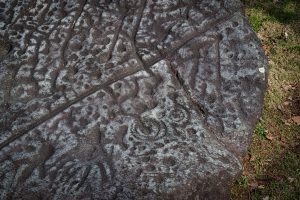
The count of the drawings and patterns on the rock is 1,548 motifs–more than 3.7 times the total of 421 petroglyphs at the Track Rock Gap petroglyph boulder in northern Georgia.
The Rock includes 1,458 cup marks, 47 curvilinear markings, ten bowl-shaped depressions, ten stick-like figures, nine rills, three concentric ring designs, three curvilinear motifs, three deer tracks, two claw-like imprints, one arc, one cross-in-circle, and one winged shape. *
Judaculla Rock has more petroglyphs than any other known boulder east of the Mississippi River!
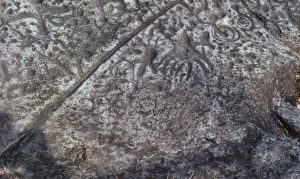
The carvings on Judaculla Rock are still a mystery. Recent studies have revealed that Judaculla Rock was once part of a larger site, arranged with other boulders that have since been removed or destroyed. This is but one of a large number of petroglyphs that have been found in the Southern Appalachian mountains. Such sites are just now being catalogued and studied.
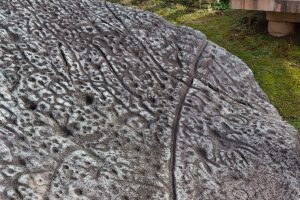
Early settlers in the area thought Judaculla Rock was the home of the “Indian Satan.” It was thought that a giant snake lived in the area and would swallow people by the dozen.
SIGNIFICANCE TO THE CHEROKEE NATION
The Judaculla Rock is a sacred site for the Cherokee Nation and was sacred to the Nation even before the colonization of North America! “Judaculla” is a poor pronunciation of the Cherokee word of Tsul’ Kalu, an ancient slant-eyed giant creature. Cherokee lore says the giant landed on the rock while jumping from one mountain to another, and thus the rock bears his seven-fingered hand print. **
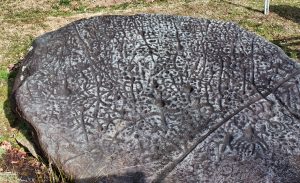
According to the Cherokee, Tsul’ Kalu had control of the winds, the rain, thunder and lightning. Tsul’ Kalu also owned all the game in the mountains, and it was only with his blessing that the Cherokee were allowed to hunt.
Some think Judaculla Rock is a physical representation of the entire landscape the Cherokee Nation inhabited, and likely has additional history and prehistory of the entire area.
Judaculla Rock is still important to the Cherokee, even though the Nation was forcibly moved from the area in 1838. The petroglyph boulder is on an old trail that linked the old Cherokee townhouse at Cullowhee, or “Juthcullah’s Place” with Judaculla’s townhouse within Tannasee Bald. The Cherokee continue to regard the boulder as spiritually significant.
OTHER THEORIES
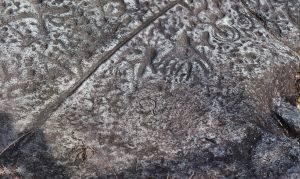
Some historians believe the etchings on Judaculla Rock to be a map of the Battle of Taliwa when the Cherokee defeated the Creek in 1755. But archeologists and geologists do not believe this theory since Cherokee were not known for etching their history on stone or rock.
Some archeologists insist that Judaculla Rock is a remnant of a pre-historic tribe who lived at the end of the Ice Age!
THE COLLABORATION TO SAVE JUDACULLA ROCK
A unique collaboration in Jackson County, North Carolina has allowed preservation of the Rock. For nearly 100 years, the Parker family owned the land surrounding Judaculla Rock and preserved the rock. In 1959, Milas Parker donated one acre around the boulder to Jackson County in North Carolina. The Parker family who owned the land, the North Carolina Rock Art Project, the Eastern Band of the Cherokee, Western North Carolina University, the NC Department of Cultural Resources and the Caney Fork Community Council collaborated to construct an elevated viewing platform around the rock. Judaculla Rock was placed on the National Register of Historic Places in 2013.
During our visit, we were lucky enough to chat with a member of the Parker family out walking his dog!
Visit this mystical and mysterious rock!
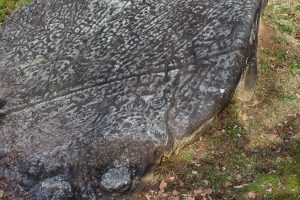
Directions:
From US 74, take Exit 85 to Business Route 23 through Sylva, North Carolina. Stay on Highway 23 for 1.3 miles to NC 107. Turn left onto 107 and drive 8 miles to the south. Take a left turn onto Caney Fork Road, County Road 1737. Go 2.5 miles then turn left onto a gravel road and drive 0.45 mile. The rock is on the right. There are no restrooms or water fountains. Parking is free.
*wikipedia.org. Judaculla Rock
** Atlasobscura.com Judaculla Rock